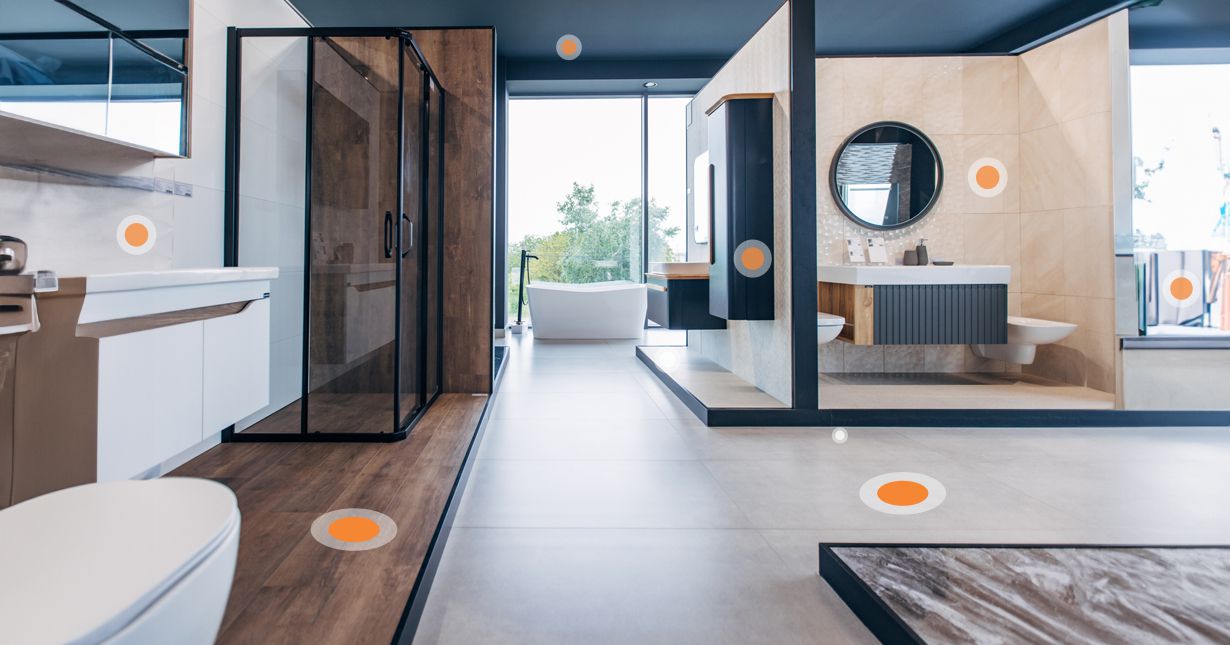Customer behavior has changed a lot over the years and most of them have accepted the transition from offline to digital shopping. And not just for regular items like clothing, accessories, and electronics, but for other things like construction materials like tiles.
However, the bigger question is how you can make their buying experience more personalized and better. An interactive solution is a virtual showroom that offers customers an immersive experience along with time availability.
Additionally, this allows tile companies to not only target B2B but also B2C customers for long-term sustainability. A digital showroom can significantly expand your reach and boost brand credibility in the crowded market.
So, let’s delve in and find out why you need a virtual showroom for your tile business.

What is a Virtual Showroom?
I know you have read what a digital showroom is, so instead let me portray a scenario for you. Imagine, you are building or redesigning a home interior and have searched the local market for the perfect tiles for it but weren’t satisfied with the final look even though you ordered a few samples to try a few designs.
Now, you search online to find some perfect pieces but how to check the finished look? That’s where a virtual showroom comes into play. It gives you a holistic view of the room in a digital setting, so you can check the finished look.
Understand how a virtual showroom can benefit your furniture business.
A digital showroom eliminates geographical barriers, and they are scalable, cost-effective, and immersive alternatives to traditional retail spaces.
Key Features of Virtual Showroom

Interactive Product Visualization
Customers can browse tile collections, change room settings, and preview different layouts in real-time. This feature helps bridge the gap between online browsing and physical inspection. It further reduces decision fatigue by allowing users to instantly compare options in a virtual environment.
Some advanced visualizers even let customers apply filters based on size, texture, material, or usage area, offering a more custom experience.
Realistic Visuals
High-definition images, 360-degree views, and AR-enabled experiences let users see how tiles would look in actual spaces. These visuals offer a true-to-life impression that builds trust and improves product appeal.
Several platforms even allow customers to upload photos of their own rooms for more accurate previews. By simulating lighting effects, room dimensions, and furnishings, the visual experience becomes even more convincing.
Learn about the cost of a virtual tour.


Audience Analytics
Gain valuable insights into customer behavior, preferences, and engagement patterns to improve marketing and sales strategies. By tracking which tiles are viewed the most, how long users stay on pages, and where they drip off, tile companies can refine their product offerings and messaging.
This data can also help in identifying product trends, customer pain points, and seasonal demand fluctuations, allowing for more strategic planning.
Integration Capabilities
Easily integrate the digital showroom with inventory management systems, CRM platforms, and eCommerce websites for a seamless experience. Integration with live chat tools, quote request forms, and appointment scheduling also helps streamline sales processes and customer support. These integrations create a unified ecosystem that improves user experience and operational efficiency.


24/7 Accessibility
Unlike traditional stores, a virtual showroom is always open, allowing customers to explore products at their convenience. Whether it’s early morning or late at night, buyers can interact with your tile offerings whenever it suits them best, creating opportunities for engagement.
This flexibility permits businesses to serve customers across time zones and reach a truly global audience.
Traditional Showroom Vs Virtual Showroom
Features | Traditional Showroom | Digital Showroom |
Accessibility | Limited to store hours | 24/7 availability |
Reach | Local customers only | Global reach |
Cost | High operational cost | Lower overhead cost |
Customer Experience | Physical, time-bound | Immersive, convenient |
Data Collection | Manual, limited | Real-time analytics |
Customization | Minimal | Highly customizable |
Scalability | Resource intensive | Easily scalable |
Customer Engagement | In-person only | Multi-channel, interactive |
Marketing Potential | Limited to physical campaigns | Digital marketing, retargeting |
Challenges Faced by Traditional Tile Business

Limited Reach and Visibility
Physical showrooms can only attract local foot traffic, restricting growth potential. Expanding to new regions often requires significant investment in infrastructure and personnel. Without digital tools, gaining traction in new markets can be slow, expensive, and risky.
High Operational Costs
Rent, utilities, staffing, and inventory management contribute to substantial monthly expenses. These fixed costs can be a major burden, especially during periods of low sales or economic downturns. Additionally, physical displays require frequent updates and maintenance, adding to the cost.
Learn the top benefits of a virtual showroom.

Inconvenient Customer Experience
Customers often have to adjust their schedules to visit showrooms during business hours, which may limit engagement. Whether traffic and time constraints can all act as barriers to physical visits. For those with mobility limitations or who live far from the store, visiting in person is simply not feasible.

Top Benefits of a Virtual Showroom for Tile Business

24/7 Availability
A digital showroom ensures that your tile collection is accessible at any time, increasing opportunities for engagement and sales. Customers can take their time to browse, revisit favorites, and make confident decisions without feeling rushed. This continuous access significantly improves customer satisfaction and purchase intent.
Immersive Product Visualization
With 3D views and interactive features, customers can better understand product aesthetics and suitability. Virtual reality and augmented reality tools make it easier to visualize tiles in different lighting conditions and environments. The immersive experience not only drives deeper engagement but also accelerates purchase decisions.


Better lead Generation and Conversion
Integrated contact forms, live chat, and engagement tracking help capture qualified leads and improve sales conversion rates. Plus, you can retarget visitors with email or advertising based on their browsing behavior. These tools collectively build a more effective sales funnel and shorten the buyer’s journey.
Learn about the top virtual showroom providers.
Reduce Overhead Cost
Virtual showrooms eliminate the need for large physical spaces and extensive staffing, leading to significant savings. This allows tile businesses to reinvest in product development, digital marketing, or customer service. By reducing fixed costs, businesses can become more agile and better equipped to weather market changes.


Data-Driven Insights and Customer Behavior Tracking
Understand which products attract the most attention, track user journeys, and custom marketing campaigns accordingly. Over time, this data can reveal trends, inform pricing strategies, and support inventory decisions. Businesses can also use insights to identify high-value customer segments and prioritize them in future campaigns.
How Virtual Showroom Improves Customer Experience
A virtual showroom delivers convenience, personalization, and confidence to buyers. Shoppers can explore tile options in lifelike settings, compare styles instantly, and make informed decisions without pressure.
Features like wishlists, virtual consultations, and AI-based recommendations further improve user satisfaction. Additionally, multilingual support and currency localization options make your offerings more accessible to international buyers. Guided tours, tutorials, and educational content can also be incorporated to support customers through every stage of their buying journey.
How to Get Started with a Virtual Showroom for Your Tile Business
Choose the Right Virtual Showroom: Look for a provider that specializes in the tiles business and offers customization options, 3D visualization, and integration features. Ask for demos, customer reviews, and references before committing.
Digitize Your Product Catalog: Invest in high-quality imagery, product details, and 3D modeling to create an appealing online showcase. Make sure to include specifications, usage tips, and care instructions for each product.
Integrate with Existing Platforms: Ensure seamless connectivity with your eCommerce site, CRM, and inventory management tools. APIs and plug-ins can speed up the integration process and minimize downtime.
Promote Your Digital Showroom: Use email campaigns, social media, and digital ads to drive traffic to your showroom. Highlight specific features such as AR tools or interactive room previews to attract attention.
Train Your Team: Equip your sales and support staff to guide customers through the virtual experience. Offer virtual consultations or live video tours to personalize the buying process.
Gather Feedback and Improve: Monitor customer feedback, usage data, and performance metrics to continuously refine your virtual showroom strategy. This iterative approach ensures long-term success.
Conclusion
In the era where convenience and technology shape buying behavior, a virtual showroom solution is no longer a luxury; it’s a necessity for tile companies. From improving customer experience to reducing costs and improving sales performance, the benefits of a digital showroom are undeniable.
Whether you are looking to future-proof your operations, increase your market reach, or offer unmatched shopping experiences, going digital is the answer. Don’t let your tiles business fall behind—embrace the digital shift and stay ahead of the competition.
The future of tile retail is virtual, and now is the perfect time to take the leap. A well-executed virtual showroom strategy not only drives immediate results but also positions your brand as an industry innovator for years to come.
Interested in virtual showroom development for your store? Contact our team.
